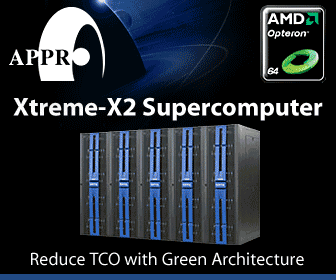ACADEMIA
July 15 application deadline to apply for computational time on TeraGrid
 For this allocation period, Oct. 1, 2008 – Sept. 30, 2009, researchers may request medium allocations, or large allocations greater than 500,000 service units (SU) of computer time; each SU represents one processor-hour a researcher can use on one of the TeraGrid’s powerful computer systems. During the most recent round of requests in June, 109 proposals were submitted, resulting in allocations totaling more than 48 million SUs and 109 terabytes (TB) of data storage. TeraGrid will host a teleconference to provide step-by-step instructions and answers on how to write and submit a successful proposal at 2-3:30 p.m. (Central Time), Thursday, June 26. Call 1-866-740-1260 and enter Access Code 8229741. To view the presentation online during the talk, visit www.readytalk.com during the call and enter the same access code in the “Participant Login box”. Please enter your name and institution when requested. With the deployment of the computing system called “Kraken” at the National Institute for Computational Sciences (NICS), along with the additions of Purdue University’s Dell 1950 Cluster called “Steele”, and Indiana University’s IBM HS21 Bladeservers for Gateways called “Quarry”, the total computational capacity of the TeraGrid soon will exceed one petaflop. The full list of 26 TeraGrid computing resources is at: www.teragrid.org/userinfo/hardware/resources.php. TeraGrid also is making available large amounts of allocated tape and disk storage, as well as servers dedicated to the delivery of data resources via the web. These resources, available for use by individual researchers, research groups, or virtual organizations, include:
For this allocation period, Oct. 1, 2008 – Sept. 30, 2009, researchers may request medium allocations, or large allocations greater than 500,000 service units (SU) of computer time; each SU represents one processor-hour a researcher can use on one of the TeraGrid’s powerful computer systems. During the most recent round of requests in June, 109 proposals were submitted, resulting in allocations totaling more than 48 million SUs and 109 terabytes (TB) of data storage. TeraGrid will host a teleconference to provide step-by-step instructions and answers on how to write and submit a successful proposal at 2-3:30 p.m. (Central Time), Thursday, June 26. Call 1-866-740-1260 and enter Access Code 8229741. To view the presentation online during the talk, visit www.readytalk.com during the call and enter the same access code in the “Participant Login box”. Please enter your name and institution when requested. With the deployment of the computing system called “Kraken” at the National Institute for Computational Sciences (NICS), along with the additions of Purdue University’s Dell 1950 Cluster called “Steele”, and Indiana University’s IBM HS21 Bladeservers for Gateways called “Quarry”, the total computational capacity of the TeraGrid soon will exceed one petaflop. The full list of 26 TeraGrid computing resources is at: www.teragrid.org/userinfo/hardware/resources.php. TeraGrid also is making available large amounts of allocated tape and disk storage, as well as servers dedicated to the delivery of data resources via the web. These resources, available for use by individual researchers, research groups, or virtual organizations, include:
- Archival storage under the control of High Performance Storage System (HPSS), up to 100 TB of storage per allocation, for persistent, long-term storage, from Indiana University (IU) and the San Diego Supercomputer Center (SDSC).
- Dedicated disk space to support databases and data collections, from several sites.
- Dedicated computational resources in support of Science Gateways or data resources (web services for computation and database queries) from NCSA and IU.
- Large shared memory machines at NCSA and PSC.
Researchers can also apply for other resources, such as animation rendering services from IU and Purdue University (the TeraDRE resource). A detailed list of data-centric and research- and education- oriented TeraGrid resources available for allocation is described at www.teragrid.org/userinfo/data/index.php. Please submit your requests through POPS (Partnerships Online Proposal System) at https://pops-submit.teragrid.org. Applications are subject to peer review, similar to other major projects funded by the NSF. However, TeraGrid does not re-review the scientific merit of researchers with federally funded research; the existence of federal funding is taken to confirm its scientific merit. For researchers who already are funded, projects are evaluated primarily on the appropriateness of the proposal for the cyberinfrastructure resources requested. Proposals for allocations are reviewed four times a year, with proposals due in January, April, July, and October for awards beginning in April, July, October and January, respectively. For additional information, see the allocations section of the TeraGrid User Portal at portal.teragrid.org or the TeraGrid website at www.teragrid.org . For further help with the allocations process, please send email to help@teragrid.org. For people new to TeraGrid, there is a “Getting Started on TeraGrid” guide available on the TeraGrid web site, www.teragrid.org. In addition, a range of live and on-line training events and resources are available to the community, and accessible via the TeraGrid web site and the TeraGrid User Portal.
